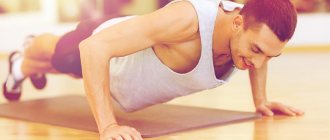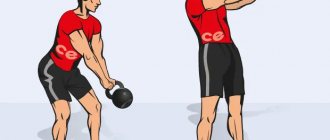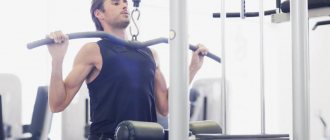Do you want to know how to pump up your pectoral muscles with push-ups without using a barbell or dumbbells? This article is for you. I'll cover 6 types of push-ups, plus 2 additional exercises that will help you develop massive chest (quickly!)
The push-up program for pumping up the pectoral muscles is based on scientific research to achieve maximum results.
I'll share with you the secrets of how to easily build bigger chest muscles by doing just push-ups.
You will learn to do:
- Test to determine your current level of training
- Selecting push-up variations that suit your fitness level
- 2 effective exercises to get the fastest growth possible
After reading the article, you can create a personal training program for yourself.
Why is push-up training so effective in developing chest muscles?
First, let me tell you how, using a scientific approach, we were able to effectively structure this program.
Push-ups are more effective than chest presses in developing strength
In 2022, a study was conducted in which 2 groups of men took part. Participants trained 3 times a week. As strength improved, the press group increased the weights, while the second group, which had a set of 10 push-up variations, progressed from simple to advanced exercises, allowing them to maintain their growth over time.
The four-week trial found that both groups achieved approximately the same level. Other studies have shown that the level of muscle growth is also comparable. From this, when answering the questions of whether it is possible to pump up the pectoral muscles with push-ups, we can conclude that by following the correct progression of loads, you can achieve the same result as doing a bench press or dumbbell press.
What do we learn from these studies to help us develop an effective program? What you need to do is train 3 times a week, choosing push-up variations that are appropriate for your current level.
Combining 3 Training Styles for Continued Growth
We use a special method for lasting progress. This method was tested on 18 powerlifters. The athletes trained 3 days a week, while slightly changing their training style:
- “easy” workout: On the first day, they did an “easy” workout focused on developing the skills they needed
- “heavy training”: on the second day, they performed a heavy workout focused on improving their strength qualities
- “Muscular Endurance” Training: On Day 3, they did a workout focused on increasing the number of reps per set.
By changing training styles, it was possible to load the muscles in different ways, as a result of which training became 3 times more effective than traditional ones (8.7% versus 2.7%).
Structuring training
We use the approach described above when creating a push-up program for the pectoral muscles. To do this, you need to choose effective exercises for each workout:
- Light Skill-Based Workout (Day 1): Perform simplified versions of the exercises with low repetitions.
- Strength training (day 2): advanced versions of exercises are performed to improve strength qualities
- Endurance training (day 3): performed to increase endurance, which is necessary for increasing the number of repetitions per set
Method number 2, wide and narrow grip
There are a lot of different push-up techniques, but not all of them are distinguished by their effectiveness, which cannot be said about push-ups with a wide and narrow grip.
- with a wide grip - works the pectoral muscles well;
- with a narrow grip - they work more on the front of the shoulders and triceps.
Important
Despite the fact that push-ups are effective exercises, they are unable to replace the entire complex that must be performed both with and without equipment. Why isn't everyone able to achieve at least some results with push-ups? The answer to this question is simple.
In most cases, this occurs due to ignorance of the correct push-up technique, how to perform them correctly, in what order, number of approaches, etc. There are many nuances when performing the exercise, and in order to achieve results, all of them must be taken into account.
Workout Order for Maximum Progress
This is roughly how your workouts should be structured, with additional exercises depending on your level.
Level 1 (1-10 push-ups)
Day 1: Light training aimed at developing skills
- Elevated push-ups: 3 sets of 5-8 reps
- Shoulder touch plank: 3 sets of 30 seconds
- Narrow push-ups: 2 sets for maximum reps
Day 2: strength training
- Negative push-ups: 5 sets of 1 rep (curl for 3-5 seconds)
- Shoulder touch plank: 3 sets of 30 seconds
- Narrow push-ups: 2 sets of maximum push-ups
Day 3: Endurance training
- Emom for 5 minutes (50% of the maximum per set)
- Shoulder touch plank: 3 sets of 30 seconds
- Narrow push-ups: 2 sets for maximum reps
Level 2 (11-30 push-ups)
Day 1: Light training aimed at developing skills
- Push-ups: 3 sets of 70% percent of maximum reps
- Shoulder touch plank: 3 sets of 30 seconds
- Narrow push-ups: 2 sets for maximum reps
Day 2: strength training
- Hand-free push-ups: 3 sets of 50% percent of the maximum number of repetitions (push-ups)
- Shoulder touch plank: 3 sets of 30 seconds
- Narrow push-ups: 2 sets for maximum reps
Day 3: Endurance training
- Emom for 5 minutes (50% of the maximum per set)
- Shoulder touch plank: 3 sets of 30 seconds
- Narrow push-ups: 2 sets for maximum reps
Level 3 (30+ push-ups)
Day 1: Light training aimed at developing skills
- Hand-free push-ups: 3 sets of 50% of your maximum reps
- Shoulder touch plank: 3 sets of 30 seconds
- Narrow push-ups: 2 sets for maximum reps
Day 2: strength training
- Unilateral push-ups: 3 sets (each side) 50% percent of maximum reps
- Shoulder touch plank: 3 sets of 30 seconds
- Narrow push-ups: 2 sets for maximum reps
Day 3: Endurance training
- Emom for 5 minutes (50% of the maximum per set)
- Shoulder touch plank: 3 sets of 30 seconds
- Narrow push-ups: 2 sets for maximum reps
This workout program puts a lot of stress on the pecs and triceps, so you should stop doing other exercises that work these muscles.
While completing the training program discussed, retake the assessment test every few weeks. As you move from one level to another, change the exercises to more advanced ones.
Increasing ladder levels
If for you two daily ladders up to 10 push-ups is not enough, it means you are either slacking on your technique, or you have been training for a long time and are in very good shape.
In the first case, you don’t need to deceive yourself - it’s better to do the same two ladders, but slowly and following all the instructions that I gave you above.
If you really don’t have enough, then everything is easy: add several levels to your ladder.
If you've done 10 push-ups and you're not doing enough, do 11 push-ups. Thus, in two ladders you will increase the number of push-ups by 11 + 11 = 22 push-ups, and you will get a total of 132 push-ups.
If this is not enough, then add level 12.
Then you will get another 12+12=24 push-ups, for a total of 132+24=156 push-ups. You see, you increased the total volume of push-ups by almost one and a half times.
Add level 13 and you get 13+13=26 push-ups, for a total of 156+26=182 push-ups per day.
In terms of time, it will only be plus a few approaches, an additional 5-10 minutes, but you can seriously increase the load.
182 push-ups a day is a good load even for a seasoned push-up athlete.
If this is not enough, add more. Here you are limited only by your experience. Seems easy - add more. BUT NEVER FORGET ABOUT THE CORRECT TECHNIQUE!
How to increase the size of the pectoral muscles
As you already understood, it is not necessary to visit the gym; you can pump up your pectoral muscles without iron by doing push-ups at home. We have already told you how to properly learn to do push-ups on the floor in order to increase the growth of your chest and how you can pump up your push-ups by practicing at home. Below you will find various variations of the exercise, each of them loads the muscles of the chest and arms, and from different angles at once, which develops the upper and lower parts of the pectorals and all the muscles of the upper body comprehensively.
The series of exercises includes the required number of repetitions necessary for muscle growth, but, interestingly, there are not so many repetitions, so you will not waste time on this workout and can complete it in a few minutes. That's about the same amount of time you'd waste waiting in line for a bench press at the gym. The time saved can be spent as you please, but it would be unfortunate if you do not use it to your advantage to pump up your pectoral muscles even better.
How to Do Push-Ups Correctly to Pump Up Your Chest
The correct push-up technique is the key to large breasts.
Nobody taught us the correct technique. The only thing you did was do push-ups somehow so that the school physical teacher would finally leave you behind.
You can do a hundred “physical push-ups” and not use your muscles as much as doing ten proper push-ups.
We will do technically correct push-ups.
It will be very difficult at the beginning. Do you know what this means?
That your flat, ironing board breast will begin to grow!
Retract your shoulder blades
One of the main questions about push-ups is: “Do you need to squeeze your shoulder blades together when doing push-ups?”
Yes, definitely.
Why do this?
So that when you get up from a push-up, you have a solid foundation. It's like holding your back firmly on the bench press. This will help engage your breasts more so they bitch start to grow.
Once I started abbreviating, push-ups became a huge benefit!
Squeeze your shoulder blades at the bottom of the movement and spread them apart at the top - this will help you better engage your chest muscles.
Drop your shoulders
Lower your shoulders towards the floor and towards your feet, as shown by the arrows.
This way you can avoid any injuries when doing push-ups.
Tighten your biceps (elbows)
If you only remember one thing, remember this clue. Your chest will burn like it has never burned in your life.
Watch this video on how to get bigger breasts from Jeff Cavaliere.
The video starts at 1:57 where Jeff Cavaliere says, “Don't push yourself off the floor—try to squeeze your biceps together.”
That is, when you do push-ups, you do not rise up using vertical pressure. You push yourself up, trying to bring your biceps and yours together.
Push your chest forward of your shoulders
In the starting position, stick your chest out so that it is closer to the floor than your shoulders.
The work is done by the muscle that is in front.
If the shoulders are in front, then the chest will not get work.
Push your chest out like you're showing it off and do push-ups. Whichever muscle is in front is the one that works.
Try to match the brushes
Jeff Cavalier demonstrates in his video how to pump up your chest:
At 8:57, when this big wrestler stops doing push-ups, Jeff moves his arms. This is exactly what you should do during push-ups.
To describe it in words, you should try to make your brushes form a Masonic triangle, as in the photo below.
It's clear that you won't be able to move your hands while they're on the floor.
But the very fact that you are trying to do this will make your chest contract more, and therefore work harder.
Imagine that the world has cracked between your hands, the whole world has cracked.
And you are trying to hold the world together with your brushes, directing them towards each other.
Place your hands already
How to place your hands correctly when doing push-ups?
That's right - narrow, as shown in the picture.
This will keep your shoulders healthy and not hurt them.
Don't listen to the advice of people who say that the wider your arms are, the better. That's bullshit.
The narrow position of your hands during push-ups helps your chest contract more and grow larger.
Do bent-over push-ups with your fists
One of the worst push-up mistakes is not pumping your upper chest.
The chest is divided into upper, middle and lower sections.
You can't isolate one department, but you can make one of the sections work harder.
A common piece of advice you'll see online is horizontal push-ups or horizontal bench presses.
Wrong.
Look at this picture.
The guy has breasts, but he, following advice from the Internet, did not pump up the upper section, and therefore looks like a fool.
The upper part of your breasts gives you maximum volume and beauty, while the lower part will just hang like a woman's tit.
Look at Arnold:
It is the upper chest that is the most beautiful and courageous.
In order to pump it up, do inclined push-ups on your fists.
This way you will work the upper chest and the rest will be involved along with it.
Also, incline push-ups increase the load on your shoulders, making them more voluminous along with your upper chest.
Bent-over push-ups with fists are easy to do.
These are the same as regular push-ups, just stand with your feet on a chair, bed, bench, and put your hands on your fists.
Why put your hands on your fists?
There are two reasons:
- Greater range of motion, hence greater chest pumping
- It's tough and masculine
Tighten your abs and buttocks
Yes, this may seem contradictory. If you're pumping your chest, then what's the point of straining your abs and buttocks?
And so that there is no leakage of power.
If you tense one part of your body while the other parts remain soft, then there is a leakage of strength in your body. Energy comes out through the relaxed area.
Jeff Cavaliere, whose video you watched above, says that if you do an exercise for one part of the body, you should tense the others so that your whole body is like a taut, tense string. That is, tightening your legs, abs, and glutes will help your arms and chest work harder.
Likewise, you need to tighten your abs, legs, and glutes when you do pull-ups so you don't leak any force.
Always try to tense your entire body during push-ups.
Now that you know all the details, it's time to create workouts. How many times to do push-ups to gain weight, how often do push-ups?
Now I will describe the most effective program for muscle growth.
But first, I’ll tell you my backstory.
Recently I started doing push-ups actively and set myself a goal of one hundred push-ups a day.
I did it like this: the first set was as much as I could, and then little by little I worked my way up to a hundred.
I'll tell you right away, I'm not superman. The first approach was 15-20 times, the remaining approaches were 7-10 times. Most people can handle this. Don't think you're too bad if you can't do 60 push-ups at once.
This method was hard, especially mentally, and I recently discovered a different, more fun approach to push-ups where you do more and it's easier mentally.
I read a book by Pavel Tsatsouline, a former USSR special forces soldier who left for the USA and taught all of America to our Russian weights. He talks about the training methods of Russian special forces.
And one of the methods used by Russian special forces to train was the good old ladder.
Chest push-up variations
With a twist
20 reps
Start in your usual position, push up, and at the highest position, rotate your entire body, including your pelvis, to one side, placing all your weight on your supporting hand, and lift your other hand up. Take the starting position. Repeat the exercise with a twist in the other direction. This will be two repetitions. Perform 20 repetitions, 10 on each arm.
With moving
20 reps
Start in a normal push-up position, but place one hand forward 15 cm from the shoulder line, and move the other slightly back, doing a push-up with your palms at different levels from the shoulder line. On the rise, change the position of your hands by moving them, or while jumping, making the exercise even more difficult. Continue switching hands until you're done.
Diamond push-ups
10 reps
Push-ups with narrow arms. To perform this variation, which is great for pumping up the triceps, place your hands so that the thumbs and forefingers of both hands form a triangle, then lower until your chest touches your hands. Then return to the starting position.
"Gorilla"
10 reps
We get into the usual position for push-ups, lower ourselves to the floor, do push-ups sharply, throwing ourselves up, lift our hands off the floor and touch our chests with our palms, and return to the starting position.
With emphasis on one leg
10 reps
Lift one leg, tighten your buttocks and do a push-up. Switch legs and repeat. Do 10 repetitions, 5 on each leg.
Weighted push-ups
Another way to make your push-ups harder is to add weights to your back. When you have mastered the ladder up to ten and want to go further, just put weights on your back.
Since you and I are doing bent-over push-ups, I recommend putting a backpack on your back and putting something heavy in it.
If you don't have dumbbells or weights, you can put a two-liter bottle of water in there.
Believe me, at first, weighting even in the form of such a bottle will make the exercise much more difficult.
Then you can add another bottle there - you will get a weight of 4 kilograms.
You can simultaneously increase the level of the ladder and put on a backpack for weighting.
Vary your exercises by surprising your muscles
After several weeks of such training, you can add variety to chest growth by changing some exercises to others. Even a small change can be enough to activate your muscles in different ways and from different angles and get maximum gains.
With offset
Get into a regular push-up position, but place one hand on an elevated, stable surface. Now bend your elbows to lower your chest, keep your elbows close to your sides, then push up to return to the starting position. Do the desired number of repetitions. Swap your hands and do the same number of push-ups. Tighten all the muscles in your torso to keep it stable and get more out of your push-ups. The legs can be spread slightly, simplifying this option.
"Spider-Man"
Start in a regular push-up position. Keeping your weight in your arms, bend your elbows, lowering your chest. As you lower, lift one foot off the floor and pull your knee toward your elbow. Keep your thigh parallel to the floor. Lower yourself, and then, rising back, return your leg to the starting position. Now repeat this with the other leg. Again, tense all your core muscles to avoid unnecessary body movements. This will allow you to move your knee closer to your elbow.
"Dive Bomber"
Get into a push-up starting position with your feet slightly apart. Arch your back into a V. Now begin to lower your head and chest towards your hands, bending your elbows. Continue moving your torso forward until your head is level with the floor. Imagine that you are doing a wave and diving under the bar. Straighten your arms and arch your back, head and shoulders facing forward. To return to the starting position, lift your pelvis up, bend your arms, lowering your shoulders and head. It was one repeat. The number of repetitions is not very important here. Instead, you need to focus on the behavior of your muscles and build a connection between your muscles and your brain, which will allow you to work more effectively on other exercises.
Complicated options
With a narrow placement of the arms, the exercises are difficult to perform, but it develops muscle groups such as:
- large chest group;
- triceps;
- biceps;
- delta;
- serratus muscle;
- press;
- gluteal muscles.
The entire body receives a healing effect, but the greatest benefits occur on the spine and posture. The exercise is especially beneficial for older people who usually lose muscle mass. The technical steps are as follows:
- Take a horizontal emphasis with your palms spaced at an approximate distance of 10 cm.
- The body is straight, movement is only due to the elbows, which in the process are strongly pressed against the body.
- The lift is carried out using the triceps, while at the top you need to linger for a few seconds and repeat the task in the same order.
Behind-the-back push-ups
The exercise is good for the lower chest and triceps. To perform, you need a bench that will serve as a rest for your hands, and your feet are placed on the floor. You need to sit on a bench or chair and rest your hands, placing them shoulder-width apart. You can rest your feet on an additional support or simply place them on the floor. The first movement is performed smoothly; a 90-degree bend should appear in the elbows, for which the forearms are directed downward. The rise to the starting state is performed by tensioning the triceps.
Jump push-ups
Pumping up in this way is useful for speed-strength qualities and coordination. However, when performing this, hand injuries are very likely, so extreme caution is required, and do not place it on a soft surface. The technical features are as follows:
- To start, you will need two supports, 15–20 cm high, which need to be installed at shoulder width.
- You need to do push-ups by pushing off the bar and landing on the floor.
- From the landing position you need to return to the stands with a quick throwing motion.
These push-ups are also called plyometric exercises and target explosive strength or neural innervation.
Cotton push-ups
This type of exercise is similar to the previous version, but requires placing your arms slightly wider than your shoulders. The feet are set shoulder-width apart. Execution requires an explosive push that makes a pop in the air.
When falling on the floor, the body should be cushioned, thereby preventing damage to the hands. Repeated repulsion is performed sharply and immediately, the maximum number of times possible.
One-handed use
The exercise can only be performed by savvy athletes, but it pumps up the chest and triceps muscles well. Technically the design is as follows:
- The position is classic, but one leg should be moved slightly to the side, it simultaneously maintains the balance of the body.
- The weight is transferred to the arm opposite to this leg, and the free one can be moved behind the back.
- It is recommended to go as low as possible; for beginners, a small range of movements is allowed.
Push-up program for 5 minutes a day
4 variations of push-ups, 100 reps in 1 super-intense set for 5 minutes.
This complex is best performed by people with experience in training and good technique for performing push-ups. This set of 4 exercises will work both parts of the chest and triceps.
This exercise cycle consists of 4 different types of push-ups, performed one after another in an intense manner, with the goal of properly pumping the chest muscles, improving muscle endurance and achieving maximum definition.
Your goal is to complete 25 reps of 4 exercises within 5 minutes as quickly as possible.
Break these reps up into as many sets as you like, and take rest breaks as needed. Your main goal is to complete 100 repetitions in 5 minutes. Try to improve your time or number of repetitions with each subsequent session.
After an intense upper body workout, this cycle (25 x 4) is a SERIOUS test even for experienced athletes. If this circuit is too much for you (at least not yet), adjust it according to your ability (for example, do 10 repetitions), and then gradually increase the load.
Push-ups with a fitball
Place your feet on the exercise ball so that your shins rest on it. Instead of a ball, you can use a chair, table or some kind of ledge.
Tighten your core muscles and keep your back straight. Perform push-ups without allowing the ball to move.
Perform a total of 25 repetitions and then move on to exercise 2.
Bench push-ups
Instead of a bench, you can use a flat ledge, a table, a fitball, 2 medicine balls, or any other surface that will allow your body to assume an inclined position.
Tighten your core and roll your shoulders back. The palms should be in line with the chest.
Perform a total of 25 repetitions and then move on to the 3rd exercise.
Spider push-ups
Take a lying position. Tighten your core muscles and keep your back straight. As you lower your body down, simultaneously bring your right knee towards your right elbow.
Tighten your abdominal muscles, hold this position for 5 seconds, and then move your leg back to the starting position. Repeat the exercise with your left leg.
Perform a total of 25 repetitions, alternating legs, and then move on to the 4th exercise.
Russian Special Forces Push-Up Ladder
Even as teenagers, we used the ladder when we did pull-ups on the horizontal bar with the boys.
But when it came to push-ups, I never heard the advice to use a ladder. But in vain. It's very effective.
Just in case, I’ll explain what it is.
In the first approach, you do only one push-up. In the second - two, in the third - three, and so on.
Once you reach level ten, you will do 55 push-ups.
Once you reach 10 push-ups, reset the ladder.
That is, you did 10, then start again with one push-up and go up to 10.
Why not go down the pyramid “8…9…10…9…8…7”?
Because when your muscles are at their peak and you go back to low reps, you give your chest a little break and you'll end up doing more.
Try it yourself. One day, try doing the ladder from 1 to 10, and then from 10 to 1 (10 repetitions are two sets in a row).
And on another day, try the ladder from 1 to 10, and again the ladder from 1 to 10.
You will do the second one a hundred times easier, but the amount of work will be the same.
Having climbed this ladder once, you will do 1+2+3+4+5+6+7+8+9+10=55 push-ups. For two times 55*2=110 push-ups.
For comparison, when I didn't use the ladder, I did 100 times a day and it was hard for me, but with the ladder the workout is a hundred times more fun and enjoyable.
If you are a complete beginner and have never done push-ups properly, then you may not be able to reach 10 (correct!) times.
Let's say you climbed the ladder to 7, but didn't get 8.
Then still go down to one and go up the stairs again to at least seven.
If you only got to 7, then you only did 28 times. This means you need to make 4 of these ladders.
If you reach 6 push-ups, then you have done 21 reps. So you need five of these ladders.
Your goal is to reach one hundred. Make as many ladders as you need.
Over time, you will rise higher and higher, and your chest and triceps will noticeably grow, and you will look much cooler.
Push-up table. How many times should you do push-ups?
This is a very important point. And it depends on the purpose of the training and the level of training. Usually they use special programs or push-up patterns.
A push-up program to increase your record might look like this. Below are the rules for its use. This set of exercises assumes that you can already do push-ups about 40 times.
weeks | Number of push-ups |
| Week 1 | 3x25 |
| Week 2 | 3x30 |
| Week 3 | 2-3x35 |
| Week 4 | 1-2x40 |
| Week 5 | 1-2x42 |
| Week 6 | 1-2x44 |
| Week 7 | 1-2x46 |
| Week 8 | 1-2x48 |
| Week 9 | 1-2x35-40 |
| Week 10 | Reaching the record: 1-2x50-55 |
Method No. 3, special complex
As you can understand: push-ups are a good and truly effective exercise, but they cannot replace the full complex that goes into developing the pectoral muscles. Therefore, to make simple push-ups an even more effective exercise and add a little variety to your workouts, you can use stools.
To perform the exercise you need:
- Take 2 stools.
- Place them (widthwise) at the level of your hands.
- Install them opposite the sofa.
- Place your feet on the sofa and place your hands on the stools.
- Take the same position as when doing push-ups.
- Next, start doing push-ups.
This method perfectly helps to use almost all the pectoral muscles. To achieve a better effect, you can work with weights; this will have an extremely positive effect on the result.











